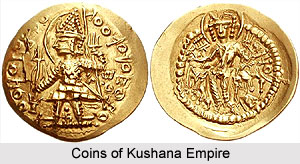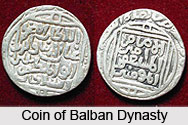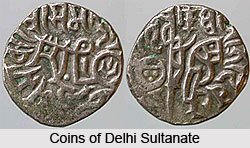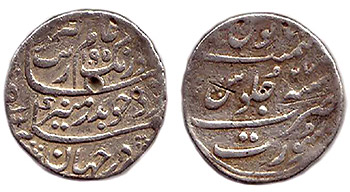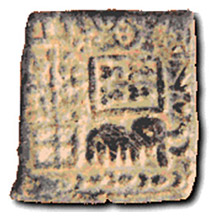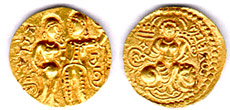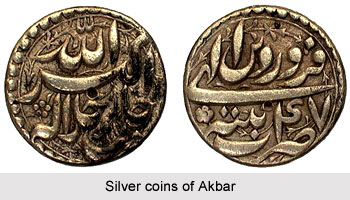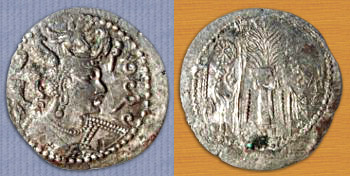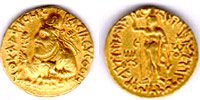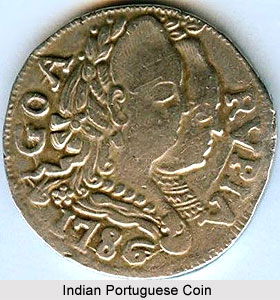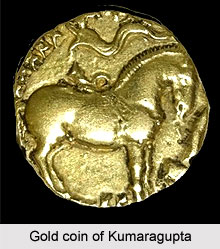 From the coinage point of view, the reign of Kumara Gupta is very significant. He had inherited a vast and well organized empire from his ancestors. Leaving aside the period towards the end of his reign, the economic conditions of his empire were very good. That is why, Kumara Gupta issued different type of artistic coins. All total 623 coins of Kumara Gupta have been found from Bayana Mudra Bhanda.
From the coinage point of view, the reign of Kumara Gupta is very significant. He had inherited a vast and well organized empire from his ancestors. Leaving aside the period towards the end of his reign, the economic conditions of his empire were very good. That is why, Kumara Gupta issued different type of artistic coins. All total 623 coins of Kumara Gupta have been found from Bayana Mudra Bhanda.
Some of the coins that are issued by Kumara Gupta can be mentioned below.
• Archer type: The obverse of such type of coins depict the figure of a king who has a bow in his left hand and arrow in his right hand. On the left side there is the figure of Garudhvaja and the name of Kumara Gupta is written. Different coins of this type also inscribe `Vijitavaniravanipati kumara gupta divam jayati` or `param rajadhiraja sri kumar gupta` or `jayati mahitalam` or `ganesho mahitalam`.
On the reverse side of the coin, there is a figure of Lakshmi seated in padmasana and `sri Mahendra` which is the title of Kumara Gupta is written on that side.
• Sword type: The king is depicted seated on the obverse of the coin. He is having a sword in his left hand and is making offerings by his right hand. The king is wearing ornaments. On his left side there is the figure of garuda-dhvaja. In the square form `gama-vajitya sucharitai kumar gupta divam javati` is written on the obverse.
On the reverse side there is a seated figure of Lakshmi on the lotus. `Sri Kumar Gupta` is also written on this side.
• Asvamedha type: The figure of horse is on the obverse of the coin. On the reverse side there is the figure of the chief queen. `Sri Asvamedha Mahendra` is written on the reverse of the coin.
• Horseman type: The obverse of the coins represents the king seated on a horse.
Different coins of this type bear one of the following legends:
`prithvitalam......divam jayatyajita`.
`chhitipati......kumar gupta d ivam jayati`.
`gupta kulamal chandro mahendra kamajito jayati`.
`gupta kulavyomshashi jayatya jaiyo jita mahendra`.
`chhitipatirajito vijayo mahendra singh-ho divam`.
On the reverse side there is the figure of Lakshmi seated on the lotus. 240 coins of this type have been found in Bayana Mudra Bhanda which indicates that this type was much prevalent.
• Lion slayer type: This type depicts the king killing the lion with bow and arrow. On the obverse of the coins `sriman vyaghrabala parakiam` is also written on this side. On the reverse is the figure of Lakshmi standing on the lotus `kumar guptodhiraja` is written on this side.
• Peacock type: The king is depicted giving fruit to the peacock. `Jayati swabhumo grevarabhi-mahendra kumar` is written on the obverse. On the reverse of the coin, there is a figure of kartikeya. `Mahendra` is also written on the reverse where Kartikeya is sitting on the peacock.
This is supposed to be most artistic and beautiful coin of the Gupta coins. The figure of Kartikeya seated on the peacock is a treat to watch.
• Pratap type: The obverse of this type of coin has the figure of a man and two women, one at the left and the other at the right of the man. Garuda-dhvaja is present at the back of the man. The name of Kumara Gupta is also written on this side whereas on the reverse of the coin Lakshi is represented seated on the lotus. `Sri pratap` is also written on this side on the coin.
• Elephant rider type: The obverse of the coin contains the figure of a king seated on an elephant and at this back is his servant with a chhatra or umbrella. The name of Kumara Gupta is also written. On the reverse side Lakshmi is depicted as standing on the lotus.
In some of the coins of this type, elephant has been shown trampling the lion and on the reverse Lakshi is having a couchsell in her left hand.
• Hippopotamus type: In this specific type of coins, king is represented hunting the hippopotamus and the name of Kumara Gupta is written. On the reverse side there is the figure of Ganga standing on crocodile and on her back is a child with Chhatra or umbrella.
• Chhatra type: There is a figure of a king with a dwarf having a chhatra or umbrella. The left hand of king is on his sword and his making offerings by his right hand. The figure of a goddess is present on the reverse side of the coin.
• Lyrist type: On the obverse side of the coin the king is depicted sitting on a couch or with a lute in his right hand. On the reverse side there is the figure of Lakshmi and `Sri Kumar Gupta` is also written on the reverse.
• King Queen type: On the obverse side of the coin the king is depicted giving something to the queen. On the reverse side there is the figure of Lakshmi and `Sri Kumar Gupta` is written.
Silver coins: Kumar Gupta I also issued silver coins. These coins are mainly of two types:
• Coins of Gajarat and Kafuawar: Half body of the king and the date in Gupta era have brief represented on the obverse of the coin. Some of the coins also contain Greek signs. `Parama bhagavata maharajadhiraj Sri Kumar Gupta Mahendraditya` is also written on the obverse of the coin.
On the reverse there is a figure of garuda and one of the following titles is written
`param bhagavata maharajadhiraj sri Kumar Gupta Mahendra.`
`rajadhiraj`.
`maharajadhiraj`.
`bhagvat maharajadhiraja sri Kumar Gupta Mahendra.`
• Coins of Madhya Pradesh: The obverse of this type coins represent the half body of the king and the date in Gupta era, but the Greek letters are not found. On the reverse side there is the figure of a peacock with stretched wings and `Ivijitavaniravanipatt Kumar Gupta Divam Jayati` is written.
• Copper coins: Though made of copper these coins are polished by silver. Two types of such coins are found. On the obverse side of the coin there is a figure of a king has been represented and some Greek letters are written. The title of `Param bhagavat rajadhiraja sri Kumar Gupta Mahendraditya` is also written on the reverse. There is a figure of Garuda and the name of Kumara Gupta is written there.
In the second type of coins there is the figure of `vedi` and under it `sriku` is written. On the reverse of the coins there is the figure of a goddess as well.
